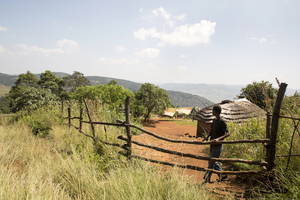



Swaziland Moves Towards Commercial Farming
SWAZILAND - In a major effort to revitalise agriculture in Swaziland, the government, the European Union and FAO have helped over 20,000 smallholder farmers produce more, higher-quality food and connect with new markets. Agriculture is on its way to become a key driver of Swaziland’s development.The vast majority of Swaziland’s 1.2 million people depend on subsistence farming. But years of economic slowdown, a devastating AIDS pandemic and recent droughts linked to climate change have made it increasingly hard for the rural population to live off the land.

According to FAO’s most recent hunger figures, one in three people in Swaziland is undernourished.
Improving the food security and nutrition of vulnerable communities and helping small holder farmers move away from subsistence farming are key objectives of the Swaziland Agricultural Development Project (SADP), a government-led initiative assisted by the EU and FAO, which is focused on creating a vibrant commercial agricultural sector.
After five years, the programme is entering a final phase. “SADP has touched our smallholder farmers,” said Swaziland's Minister for Agriculture, Moses Vilakati. “It has helped them become commercial. Continued support is necessary if we want agriculture to take a lead role in our economic development.”
Moving On
“The European Union is proud to be part of this endeavour that has reached over 20 000 farmers and has linked production to processing and marketing,” said Nicola Bellomo, the EU’s ambassador to Swaziland. “It shows that the country wants to move on.”
Set up in 2009, SADP first focused on the most vulnerable, particularly the elderly and Swaziland’s youth.
Household gardens allowed vulnerable families to grow vegetables for their own consumption, or to sell within the community. Youth groups got assistance to set up small agribusinesses, including poultry farming, pig raising, or vegetable and crop production.
Gradually, the project started disseminating good agricultural practices among Swazi smallholders, helping them to grow more, better-quality produce while preserving the environment and reducing pressure on limited natural resources.
Thousands of farmers were trained in such good practices as conservation agriculture, agro-forestry and seed multiplication.
In addition, construction and rehabilitation works in the livestock sector, water infrastructure and government services have also supported farmers in increasing their output.
Producing more food meant that farmers needed a way to sell their surpluses. So a €1 million Marketing Investment Fund was established to strengthen farmers' links to the markets by supporting agri-businesses who process and market the small holder's produce.
A Miracle
“Swaziland can make it,” said FAO’s Nehru Essomba, chief technical advisor of SADP. “They have the potential to export. In livestock, for instance. Or in niche crops. All that’s required now is some thinking.”
Thinking under SADP has already yielded an impressive record of institutional support. This is part of SADP’s long-term impact, and can lead the way towards a more sustainable, high income generating and market oriented agriculture.
National policies on research and extension have been updated, while SADP’s ultimate legacy is still in the making: a 10 year national agricultural investment plan, currently being developed.
The plan is being drafted by the government along with help from the EU and regional partners, such as COMESA and NEPAD, in the framework of Africa’s foremost agricultural development initiative, known as CAADP.
Aiming at an average annual growth rate of six per cent in agriculture by 2015, the governments that have signed up to this Africa led initiative have agreed to increase public spending on agriculture by a minimum of 10 per cent of their national budgets.
In Swaziland, such a paradigm shift could make agriculture the driver of the country’s own ambitious development plans.
“Our role is to help catalyse them,” said Nehru Essomba. “And then, the miracle can happen.”








